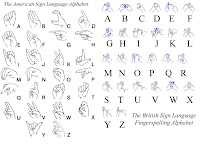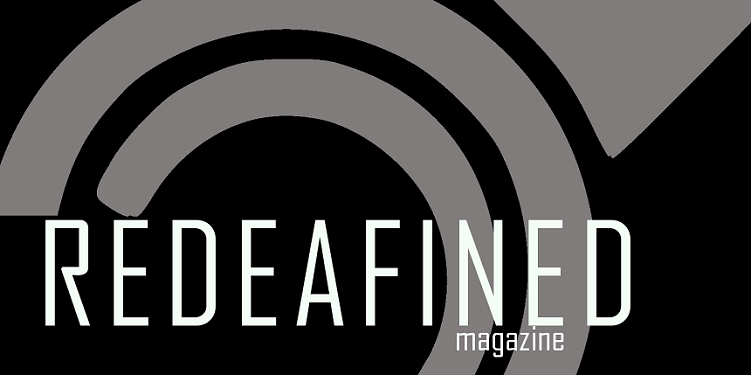Q:What is ASL?
A: ASL stands for American Sign Language, a language with its own vocabulary and visual/spacial grammar; ASL incorporates hand shapes and movements, gestures, facial expressions, and body movements.
Q:What is the sign language alphabet?
A: Many people learn the ABCs in ASL, but in everyday ASL conversation, the manual alphabet is not needed as often as hearing people may think. The ASL alphabet is used to fingerspell names, proper nouns, or words borrowed from English or other languages, but not as a replacement for signs. Most ideas can be conveyed by signs alone.
Q: Who made up ASL? When did it start?
A: ASL is actually a combination between a form of sign language widely utilized on Martha's Vineyard in the 17-1800s (where there was a large deaf population due to genetic prevalence), and French Sign Language. The two languages mixed, and were subsequently standardized, when a Frenchman Laurent Clerc and American Thomas Gallaudet founded the first school for the deaf in Hartford, Connecticut in 1817.
Q: Is ASL an actual language, or just gestures?
A: ASL is its own language with a non-English grammar, vocabulary and syntax, and was recognized as an official language by linguistic researchers in the 1960s who found it to fulfill all the standards required of a full and natural language. There are other signed systems, such as SEE (Signing Exact English), which borrow signs from ASL but modify them with English conjugations like "ing," and employ English syntax and sentence structure. SEE and other types of manually coded English are signing systems, not complete or natural languages.
Q: What's ASL grammar like?
A: ASL employs a visio-spacial grammar, and because of its visual nature, ASL sentence structure is often likened to drawing a picture. For example, the English sentence "The green cup is on the table" would be signed in ASL something like "TABLE, CUP (COLOR GREEN) CUP-ON" so that first the table is set up, then the cup and its descriptor, and then the cup's place in relation to the table. Because of its lack of the verb "to be" and the noun, then adjective word order, ASL is actually more syntactically and grammatically similar to Japanese than English.
Q: Is sign language universal?
A: No. Since sign languages develop naturally through communities of Deaf people conversing with one another (the same way that spoken languages develop), there is no universal sign language. Sign languages, just like spoken languages, are rooted in cultural references pertaining to the local society. For example the signs for "boy" and "girl" (or gentleman and lady) in ASL reference a cap and a bonnet string, whereas the signs for "man" and "woman" in Croatian sign language suggest a mustache and an earring, respectively.

Q: Do all English-speaking countries sign ASL?
A: No. Because signed languages are not related grammatically to spoken languages, there is no relation between the signed languages of English speaking countries. ASL, British Sign Language (BSL), and Australian Sign Language (AusLan) are all very different, with BSL and AusLan even employing a different two-handed manual alphabet. ASL is, however, widely used in the English-speaking parts of Canada. As previously mentioned, ASL is actually most closely relationed to French Sign Language (LSF).
Q:Why doesn't someone just make up a universal sign language?
A: For the same reason people don't make a universal spoken language; because it is difficult to develop and promote, and would not be a natural language the way ASL or other indigenous signed languages are. There is an International Sign Language, the equivalent of Esperanto, but it was artificially developed and not widely used for everyday conversation.
Q:What are the functional limits of ASL?
A: There are no limits of what can be discussed in ASL; philosophy and physics can be just as easily addressed as in English or any other spoken language. Proper nouns borrowed from English can be fingerspelled, but an over-reliance on this is not necessary in most conversations. In fact, the visual nature of ASL often makes describing situations with a lot of movement easier than it would be in a spoken language, because the exact nature and trajectory of the movement can be illustrated with classifiers, a component of ASL grammar in which handshapes can be used as stand-ins to describe the movement, location or appearance of an object or person.
Q: What is ASL poetry?
A: Because ASL does not have written or audio-based components, ASL poetry is a performance art. ASL poets employ stringent restrictions on the number and pattern of handshapes they use within a poem, which is known as ASL rhyme. For example, the signs for "farm," "mother" and "trees" all consist of a "5" handshape, so these words are said to be alliterative in ASL. There is also a subset of ASL poetry called ABC stories, in which the poet tells a story with each line beginning with handshapes of the consecutive letters of the alphabet. ASL number stories, using number handshapes in sequence, are a similarly challenging form.
Q: Does learning ASL prevent kids from learning how to talk?
A: Absolutely not! This is an myth perpetuated by some speech therapists, but it has been debunked by a multitude of recent evidence. The brain-boosting benefits of bilingualism have been scientifically proven, and the big boom in teaching sign language to hearing babies only confirms the fact that early exposure to any and all language is better for all children. Check out our other posts about the importance ASL/ English Bilingualism see our guest post at Language on the Move, our interview with "Signing Time" founder and mother of a Deaf daughter Rachel Coleman, and this great video of the inner-workings of a signing two-year-old's mind revealed during dinner table conversation. For more about the myth that suggests ASL lowers reading levels (also false!), click here.
The graphic above illustrates the fingerspelling alphabets for ASL and BSL/ Auslan. Even though Americans and Brits, and Australians all speak English, their sign languages are very different:

No comments:
Post a Comment
Note: Only a member of this blog may post a comment.